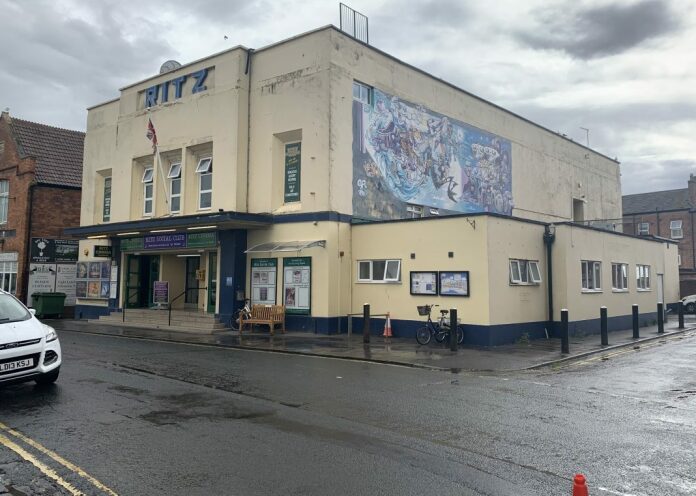The developer behind controversial plans to install a large new electronic advertising billboard on the side of Burnham-On-Sea’s Ritz Cinema has lost their appeal to try and overturn the district council’s rejection of the proposals.
Sedgemoor District Council turned down the plans from the Ritz Social Club in Burnham’s Victoria Street to install a 6m x 3m illuminated digital display on the north-facing cinema wall, replacing the current street art.
Town councillors also objected against the plans amid concerns over light pollution, the bilboard’s appearance within a Conservation Area, and road safety.

However, marketing company Alight Media submitted an appeal to The Planning Inspectorate in a bid to try and overturn the decision.
Now, The Planning Inspectorate has formally rejected the appeal, concluding: “The advertisement would cause significant harm to the visual amenity of the area and to public safety.”
It comes after several nearby residents spoke out against the plans. Ollie Hulme said last night: “We are delighted that the Planning Inspectorate has for once agreed with local residents, the Town Council and Sedgemoor District Council and rejected this application.”
“However, it is of enormous regret that we realise that national companies, with no connection to Burnham-On-Sea, interested solely in making money, can exploit the troubles of the hospitality sector and create division and discord where there was none before and leave with no consequences to themselves. We have always been good neighbours to the Ritz Social Club and they to us, and we would encourage everyone in Burnham to support this local social club.”

Planning Inspectorate’s judgement:
“24 Victoria Street is a large flat-roofed building positioned within a corner plot formed by the junction of Vicarage Street with Victoria Street. The building is part of the wide range of uses that are found in the town centre, and as it is one of many historic buildings in the area, it contributes towards the richly varied street scene that reflects the development of the town over time. Victoria Street is one of the principal roads within the town, comprising a mix of commercial, service and residential uses. By contrast with the diversity of uses found in Victoria Street, along the seafront there are elegantly grand residential properties and public open areas. This separation of uses is a distinct element of the significance of the conservation area, reflecting the development of the town as a coastal resort, and creating a vibrant and dynamic character and appearance.”
“There is a single storey side extension to No 24 above which is a long, tall, rendered wall, part of which has been painted with a mural. The building is a prominent feature within the area, in part reflecting its community role within the town, but also due to its corner position and its distinctive, high quality style and form. It is one of several community buildings in the area, and like the nearby church, it is a building that makes a focal point within the townscape. The flank wall of the building can be seen from long distances away when approaching from the north, and it can also be seen from the Esplanade. As such the building makes a positive contribution to the character and appearance of the conservation area.”
“The provision of a large, digital advertisement upon the flank wall of No 24 would appear harmfully intrusive. Despite the diversity of uses near the appeal property, the large size of the advertisement along with its digital illumination and its prominent position would make it a dominating addition to the area. The advertisement would be visible from long distances away, particularly when approaching from the north, and the introduction of a large, illuminated advertisement in an area characterised by historic buildings would harmfully draw the eye.”
“The images would be static, but the bright, clear nature of the illuminated display along with the sequential changing of images would be an alien addition within an area defined by its historic buildings and the absence of any other such large, illuminated advertisements. Although part of the flank wall is currently decorated by a mural, the size, illuminated nature, and changing images of the advertisement would make it a much more intrusive and eye-catching feature, including for the occupiers of nearby residential properties. Such a large, illuminated advertisement, and one with a modern appearance, would dominate the area. Although there is street lighting present, the advertisement would be much brighter, to the detriment of the attractive visual cohesion of the area, as well as being a disruptive addition to nearby residents.”
“The advertisement would also detract from the prominence of the church. Like the appeal property, the church has a clear legibility as a focal community building, and this functional and social importance is enhanced by the open nature of its churchyard setting. Whilst there are other large advertisements near to the church, including that close to the junction of Manor Road with Victoria Street, they are much smaller in size and are not digital, and the images they display do not change. Given this, the appeal advertisement would be overly dominant. It would unacceptably detract from the setting of the church and its social and functional importance within the town, as well as having a prominence that would detract from the significance of the conservation area.”
“The appellant refers to the frequency of similar advertisements found in urban areas, including in other coastal resorts, and that the advertisement could be used by local businesses. Nevertheless, the circumstances of this case are such that the advertisement would be unacceptably and harmfully conspicuous and incongruous within the surrounding area. The advertisement may allow the side of the building to be re-furbished, but this could occur independently of the installation of the advertisement. Remote servicing would be a benefit for the appellant, but this would not mitigate the significant and unacceptable harm to the area.”
“For these reasons, the advertisement would unacceptably harm the visual amenity of the area and would neither preserve nor enhance the character or appearance of the conservation area. Given its digital nature, size, position, and the changing images, the conditions suggested by the parties, including those to control illumination and changes of the display, would not ameliorate the harm that would arise.”
“Although not decisive in advertisement cases, I have had regard to Policies D2, D25 and D26 of the Sedgemoor Local Plan (2019) (LP), which seek amongst other things, high quality design that avoids harm to heritage assets, that responds positively to and reflects local character, and respects the amenity of the occupiers of nearby buildings. In addition, objectives of the National Planning Policy Framework (the Framework) seek to control advertisements in the interests of amenity and public safety, recognising that the quality and character of places can suffer when advertisements are poorly sited and designed. As the advertisement would unacceptably harm the character and appearance of the area, it would fail to accord with the Framework nor with the above reference LP policies.”
On public safety, the planning inspector states: “The roads near to the appeal property are busy as they provide access to the town centre and to nearby services and facilities. There are also numerous on-street parking spaces in the area. The advertisement would be visible to users of the highway both when approaching from the north and when negotiating the junction of Victoria Street with Vicarage Street.”
“Although the advertisement would be set back from the road junction, given its height, size and illumination it would be clearly visible within the surrounding area, including from long distances away. The advertisement would also be visible when exiting and entering Vicarage Street. Whilst the images would be static, the advertisement would be in the clear line of sight of motorists where there are a number of distractions, including pedestrian and cyclist movements, as well as other motorists using the car parking spaces. Even with the presence of street lighting within the area, the large size of the advertisement would make it brightly conspicuous and distracting throughout the day and night. Although the images would change smoothly, such changes would be distracting to users of the highway, and especially so because of the frequency of change of the images. The advertisement would form a distracting feature, and this distraction would be detrimental to public safety in an area where users of the highway would need to concentrate.”
“The appellant has referred to advertisements being a common feature of urban areas, reflecting the commercial nature of an area, and reference has been made to an advertisement allowed at appeal in Bridgwater (Ref: APP/V3310/Z/21/3280621). However, this appeal was for a replacement advertisement, and with regard to this difference the case does not form a precedent for allowing the appeal before me. Furthermore, the circumstances of this case are such that the presence of large, bright, illuminated sequential images in an area where there are no other similar such advertisements or signs would harmfully exaggerate the distracting nature of the proposal. It might be the case that the advertisement could display public health information, but neither this nor the absence of accident records near to the site would mitigate the harms that I have identified.”
“Thus, the advertisement would be unacceptably harmful to public safety, and conditions relating to the change of the images and illumination would not be sufficient to alleviate the harm. The advertisement would fail to accord with objectives of the Framework that seek to control advertisements in the interests of public safety. Nor would the proposal accord with LP Policy D13, which seeks amongst other things, to enhance road and personal safety, including for pedestrians, cyclists and other users.”
“The appellant has referred to the advertisement being the sustainable development that is sought by the Framework. However, the Regulations and the Framework make it clear that advertisements should be subject to control only in the interests of amenity and public safety, albeit taking into account the provisions of the development plan, in so far as they are material, and any other relevant factors. Consequently, economic benefits arising from the advertisement are not matters for my consideration.”







